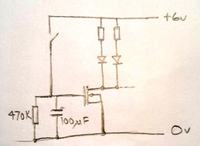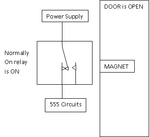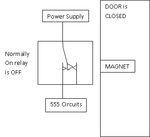DOD
Newbie level 3

I am building a battery powered device (preferably 6v from 4xAA’s) that will drive about 5-10 bright LED’s for 10-15 seconds when a door is opened.
When LED’s power off I would like power to be automatically disconnected altogether so there is zero residual current.
There should be a trigger that restarts the timer (can be the same trigger that starts it in the beginning), but the idea is to completely disconnect power when not in use to maximize battery life.
I understand that the cmos 555 draws only about 110ua in standby, but this device will need to sit idle for days at a time waiting for a trigger. I want the battery replacement time to be measured in months or years, rather than weeks.
I have scoured the web for suggestions but come up empty handed.
Can anyone suggest a circuit for me?
When LED’s power off I would like power to be automatically disconnected altogether so there is zero residual current.
There should be a trigger that restarts the timer (can be the same trigger that starts it in the beginning), but the idea is to completely disconnect power when not in use to maximize battery life.
I understand that the cmos 555 draws only about 110ua in standby, but this device will need to sit idle for days at a time waiting for a trigger. I want the battery replacement time to be measured in months or years, rather than weeks.
I have scoured the web for suggestions but come up empty handed.
Can anyone suggest a circuit for me?





